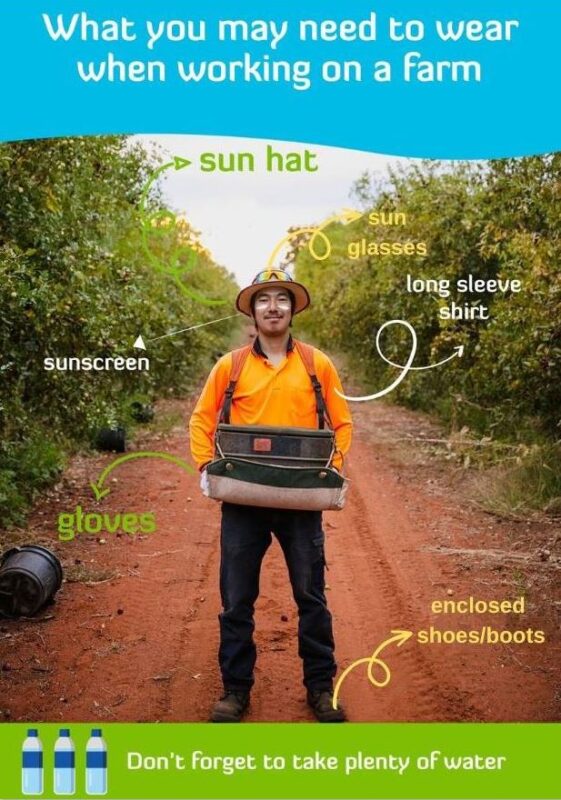Summer is approaching and there is no denying Australia can and will be hot.
And that means if you’re outside on a farm then you’re likely in the firing line for an assortment of heat-related illnesses so you must take precautions, know the symptoms, and be able to treat yourself or others in an emergency.

Given the nature of your work, staying out of the sunlight will be a challenge, so if you have to be outside during the day, then check the UV levels. Cancer Council Australia’s free SunSmart app is a great way to check the UV Alert, as well as weather pages of all Australian daily newspapers, the radio, and the Bureau of Meteorology website or app. Remember, whatever the weather, even when it is cooler or overcast, you can still be exposed to UV radiation.
Prevention
The best form of defence. If you’re an overseas visitor and not from a hot climate then the best thing to do is get acclimatised by limiting time spent working in heat until you’re conditioned to it. Under each heat-related illness listed below will be some further information on symptoms, how to treat and what precautions you could take to minimise your risk of falling ill on the farm.
| What | Symptoms | Treatment | Prevention | |
| Heat Rash | A skin irritation caused by sweat. | Small red spots or clear blisters where sweat collects, such as the armpits, back, chest, or any other folds of skin | Normally goes away without treatment, however, there are medicines available from a pharmacy or chemist to ease the symptoms of itching. | Loose cotton clothing can help prevent overheating, so avoid fabrics that irritate your skin (such as wool). Try to take regular breaks in a cooler, less humid environment when possible. |
| Sunburn | Damage to the skin caused by exposure to ultraviolet (UV) radiation. When the UV level (also called the UV Index) is 3 or above, the sun’s rays are strong enough to damage your skin. | Your skin will become hot, red, and painful within hours. You may also peel, which is effectively your body shedding dead or damaged skin cells. | Take a cool or lukewarm bath or shower. Use paracetamol or ibuprofen to reduce pain and swelling and drink plenty of water. You can also use an ointment or cream to soothe sunburn. Importantly give your skin the time it needs to repair. Stay out of the direct sun until the redness, peeling, and pain have disappeared. If you develop blisters, leave them alone, do not break them open or pop them as they are prone to infection and will prolong your healing. | Slip, Slop, Slap! Slip on clothing that covers as much skin as possible; Slop on a broad spectrum, water-resistant SPF30 or higher sunscreen; Slap on a broad-brimmed hat to protect your face, head, neck, and ears. |
| Heat Exhaustion | The body’s response to a loss of water and salt from excessive sweating. | Heavy sweating, headache, nausea or vomiting, dizziness, rapid pulse rate, and fast, shallow breathing. You may also experience muscle pains and spasms (which are also referred to as heat cramps). | Find a shady, cool place to rest. Drink plenty of water, remove excess clothing and place cool packs under the armpits or back of the neck. It is important to seek urgent medical attention or call an ambulance if symptoms worsen or there is no improvement | Drink lots of water throughout the day and monitor your sweat levels. Take regular breaks out of direct sunlight and rest in shady or cooler places. |
| Heatstroke | A life-threatening condition in which the body overheats to above 40.5 degrees Celsius and it can no longer maintain a healthy temperature. | Rapid pulse rate and fast, shallow breathing. Difficulty speaking or slurred speech, problems concentrating, aggressive or strange behaviour, dizziness, confusion, headache, nausea or vomiting, intense thirst, dry and swollen tongue, seizures, and loss of consciousness. | Heatstroke is a medical emergency and requires immediate first aid as quickly as possible. If you witness someone suffering from suspected heatstroke you should immediately phone 000 and ask for an ambulance. You can give the person sips of cool fluid and ensure they are in a cool, shady place. Lower their body temperature any way you can by removing excess clothing, sponging, or spraying them with water, and place cool packs under their armpits or back of their neck. If the person is unconscious, place them on their side with their mouth down and chin up to prevent possible suffocation. | Slip, slop, slap by wearing loose-fitting, lightweight cotton clothing, apply sunscreen and wear a hat. Drink plenty of fluids and take it easy during the hottest parts of the day, taking regular breaks and resting in shady, cooler places. |
In summary, you should treat heat-related illnesses with the respect they deserve. Most preventative measures are the same, just make it a routine to check the UV Index before you start work, take and apply lots of sunscreen regularly throughout the day, stay hydrated, and look to take regular breaks in shady, cooler spots such as under trees or even back in your car with the air conditioning on!
Be sensible, stay safe, and enjoy your farm experience this summer.
Resources:
https://www.healthdirect.gov.au/heatstroke
https://www.healthdirect.gov.au/sunburn
https://health.nsw.gov.au/environment/beattheheat
